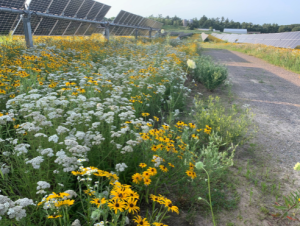Large scale solar development is rapidly expanding in Wisconsin. Utility-scale solar (USS) farms are large, ground-mounted solar arrays that produce electricity for the grid. In 2020 there was 150 MW of USS capacity in the state, enough to power roughly 22,500 homes. By the end of this year, the Wisconsin Public Service Commission (PSC) anticipates 650 MW of capacity will be online in the state, enough to power nearly 100,000 homes. Last year, the PSC approved six USS projects, totaling another 1,125 MW capacity, enough to power 170,000 homes.
These projects are critical pieces of the state’s effort to clean up its electricity sector, as WI’s electricity grid is the 9th most carbon-intensive in the country, ahead of all neighboring states. Solar facilities emit no air pollution while they are generating electricity. Displacing fossil fuel electricity generation (i.e., coal and gas) and their associated climate warming and harmful air pollution is the most obvious environmental benefit of USS projects in Wisconsin.
Indeed, public health experts say that speeding up the transition to renewable energy is the most important action we can take to combat climate change. The public health benefits of reduced air pollution through solar generation are estimated to be 5-10 cents per kWh, which is more than the cost of the solar-generated electricity itself (3-4 cents per kWh).
However, there are additional, important, local environmental benefits to appropriately sited, designed and maintained USS projects.
In Wisconsin, these projects are being sited on agricultural land, which is attractive to developers as it is clear of trees and relatively flat. Intensive annual row crop agriculture in Wisconsin is a primary contributor to many of Wisconsin’s most pressing water quality problems, including contamination of drinking water from nitrates and pesticides and pollution of lakes and rivers from phosphorus and soil erosion.
When a solar farm planted with native grasses replaces annual row crop agriculture, nitrogen fertilizer inputs are eliminated, and pesticide applications are greatly reduced. The perennial, deep-rooted grasses under and around the panels hold the soil in place, reducing sediment and phosphorus pollution into nearby waters by 75%-95%, compared to row crop agriculture where the soil is disturbed and often bare for parts of the year.

The perennial grass cover also helps to promote carbon storage in the soil. The historic conversion of forests and grasslands to cropland has released 25-50% of the soil’s carbon into the atmosphere, and solar farms can help to reverse this process. Beyond helping to mitigate climate change, this soil carbon accumulation helps to improve soil health, making it potentially more productive for farming after decommissioning.
It is also becoming standard practice for USS proposals to plant pollinator-friendly habitat around the panel arrays. Pollinators like bees and butterflies have experienced significant declines in Wisconsin, due in large part to the loss of habitat from other land uses like agriculture. A recent study found that within 5 years of the installation of a solar farm in MN, insect abundance tripled, including a 20-fold increase in native bees.
Finally, in other parts of the country solar farms are being placed on undeveloped land, resulting in significant habitat loss and fragmentation concerns. In contrast, we have the opportunity to improve wildlife habitat in Wisconsin when solar farms are placed on row crop fields, which are (at best) marginal habitat for wildlife. The perennial native vegetation, paired with wildlife-friendly fencing (fences with openings large enough for smaller wildlife to pass through) can create new habitat for local wildlife.
Current estimates indicate that we will need 150,000-200,000 acres of solar farms in the state to meet carbon neutrality goals. This amounts to less than 2% of the state’s farmland—and is less than a quarter of the farmland already being used to produce energy in the form of corn-based ethanol. Although solar development of this land will largely mean taking it out of crop production, as outlined above, conversion to a solar farm can provide a net increase in local environmental quality. These potential local environmental benefits can be maximized through appropriate siting, design, and maintenance of USS facilities, For example, prioritizing marginal fields that are disproportionately contributing to water pollution will help to make WI’s transition to renewable energy as sustainable and environmentally friendly as possible.
